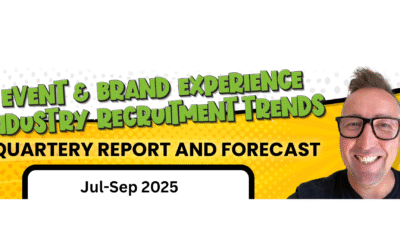We all hear a lot about candidate experience, culture, values. These are lovely words, but most hiring still starts from the same place: “we’re hiring, aren’t you lucky”. That mindset is why many hiring plans end with the ‘closest match’ rather than the right hire, and why those hires are often gone within 12–18 months. There is one question you simply must ask yourself when you start hiring and it’s such a key question that I would go so far to say don’t hire unless you can answer it. The question is: “Why would I leave where I am to come and work for you?”
The only question that matters
Before you write an advert or phone a recruiter, consider this: What would genuinely make someone leave their current role to join your company? If the first thing that pops into your head is “we’ve got a great culture,” you’re already in trouble, because everyone says that. “Great” is subjective. Evidence isn’t.
Real answers could be: three internal promotions in the last 18 months; retention at 92%; clear progression pathways; a line manager who actually coaches; meaningful sustainability actions (not just a page on the website). If you don’t have specifics, go fix the job package and the environment before you look for applicants.
Likeability hiring kills diversity (and retention)
Most interview processes really work like this: check the CV for baseline competence, then choose the person you liked the most or performed best at interview. That’s not selection; that’s social preference dressed up as judgement. You get teams of people “we’d love to work with,” not teams that push you, challenge your assumptions, and raise the bar. Diversity stutters, performance plateaus, and 12–18 months later you’re back in market muttering about “fit.”
The job is 60% skills, 40% ‘Fitability®
The job description covers about 60% of what you’re paying for – the hard skills and outputs. The other 40% is the reason they’ll still be there next year: motivations, manager match, pace and style of decision-making, tolerance for ambiguity, appetite for blunt feedback. I call it Fitability®. Measure it deliberately – if you don’t, you’ll keep hiring people who can do the work but don’t want to live the work your way.
Interviews aren’t a performance – please make them two-way and relevant
Stop asking vague questions. Nobody needs to hear a monologue about “leadership” if what you mean is: Can you performance manage someone out? Have you ever exited someone fairly? Ask decision-grade questions: the ones that directly affect whether both sides should proceed.
If you’re going to ask candidates, “Why do you want to leave your current role?”, be ready to answer, “Why did the last three people leave yours?” That’s not cheeky; it’s symmetry. Good talent is assessing you as hard as you’re assessing them so invite it. If your interview allows “two-way questioning,” don’t get huffy when the questions are actually hard.
Hire the best, not the nearest
Too many teams hire the “best of who applied” rather than the “best for the role.” When your shortlist doesn’t contain the person you need, start again. Reset the brief. Change the channel strategy. Rewrite the proposition. Settling is how you end up paying twice.
Do the due diligence before you post the job
Why does this vacancy exist? If someone left, why? If three people left the same team for the same reason – maybe it was the pace, blunt comms style, chaotic planning – then solve that before you add another body. If it’s a new role, why isn’t there internal interest? If you’ve merged teams, what clashes are you managing? Get honest internally so you can be realistic externally.
Know your difference (and prove it)
I’m not a fan of the term “USP.” Call it your differentiator, your edge, your actual true reason to join. Just don’t make it vague. If your technology looks like everyone else’s but your service is streets ahead, stop leading with the tech. Lead with the service. Show me the NPS, the renewal rate, the client testimonials, the out-of-hours saves.
The same goes for culture. If you say, “we promote from within,” list the promotions. If you say, “we care about development,” show the budget, the framework, the mentor outcomes. If you say, “we’re flexible,” define it in days, hours, parameters. Precision is persuasive.
Policies signal who’s welcome (and who isn’t)
The little stuff isn’t little. A “dog-friendly office” is heaven for some and a hard no for others (allergies, phobias, distractions). Mandated socialising, loud open-plan spaces, cameras-on rules – these choices draw a line around your talent pool. That’s fine but be deliberate. Know who you’re optimising for and be upfront so people can self-select in or out without wasting time.
Ask only the questions that change the decision
A simple rule for both sides: if the answer won’t change your decision, don’t ask the question. “Tell me about your leadership style” invites waffle. “We move fast and feedback is blunt—talk me through a time you thrived in that environment, and when you didn’t” is relevant. Replace generic with specific and watch things improve.
A practical checklist to fix your next hire
- Write the answer first. One paragraph: “Why would someone leave for us?” Include three proofs (promotion, retention, development, impact).
- Split the spec. 60% skills, 40% Fitability®. Define the environmental realities (pace, feedback style, ambiguity, travel, office norms).
- Design a two-way interview. Three decision-grade questions each. Swap them in advance. Expect, and welcome, hard questions.
- Post-mortem the vacancy – why the last person left, what you’ve changed, what still needs work.
- Refuse the “nearest.” If the shortlist’s wrong, stop and reset. Don’t buy the ‘almost fit’.
Do that, and your pipeline gets smaller but sharper. You’ll stop wasting hours on nice chats with people who were never going to stay.
In the end, great hiring isn’t about who you like. It’s about who will raise the bar and still be there in 18 months because the job, the manager, and the environment match what they actually want.
Start with the only question that matters. If you can’t answer it yet, don’t recruit yet.






